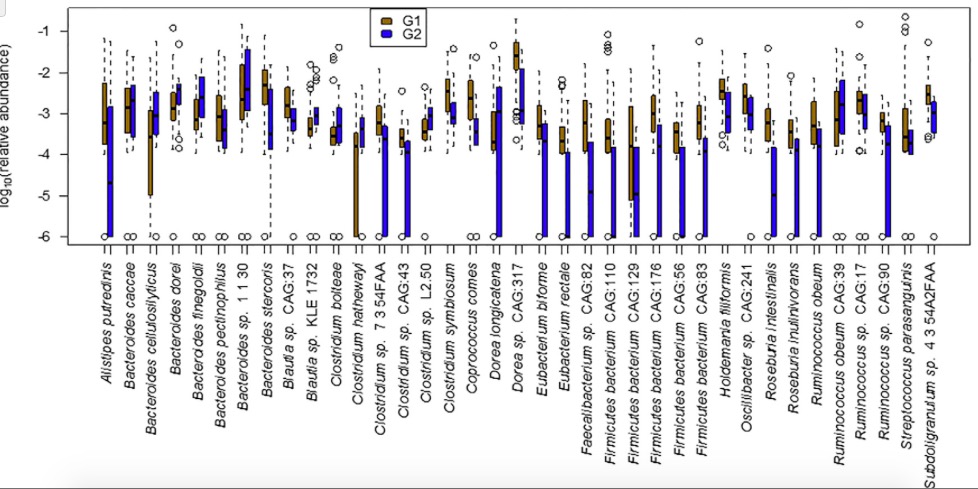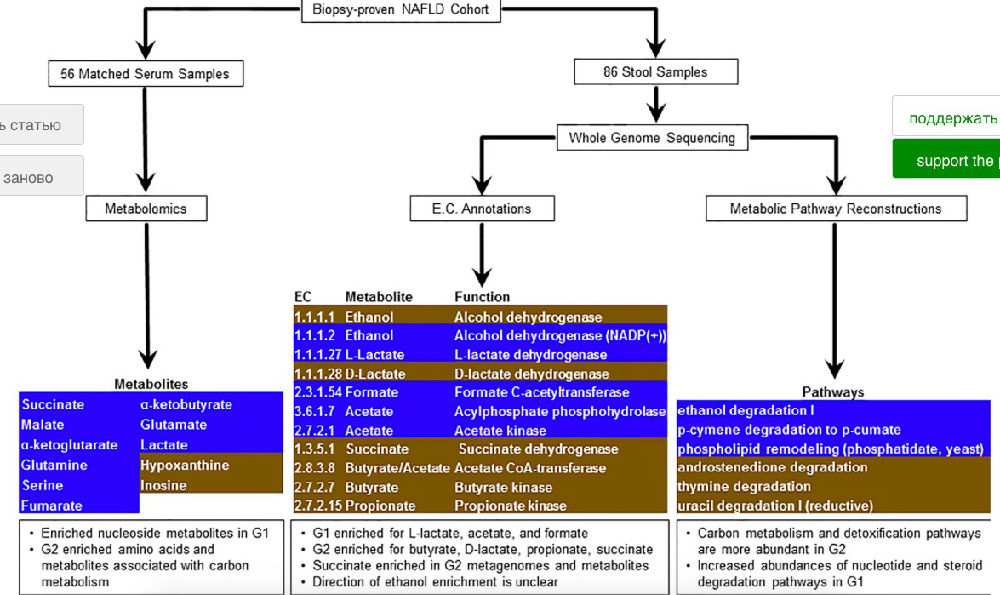博文
基于肠道微生物区分非酒精性脂肪肝
||
文章:Gut Microbiome-Based Metagenomic Signature forNon-invasive Detection of Advanced Fibrosis inHuman Nonalcoholic Fatty Liver Disease
杂志:Cell Metabolism
时间:2017
链接:http://sci-hub.cc/10.1016/j.cmet.2017.04.001
研究目的:Our aim was to develop a panel of gut micro-biome-derived biomarkers for the non-invasive diagnosis of advanced fibrosis in NAFLD.
研究策略:86个样本的训练集,49个样本的验证集。86 patients with biopsy-proven NAFLD were included. Group 1 (G1) (n = 72) – mild/moderate NAFLD patients with stage 0-2 fibrosis, and Group 2 (G2) (n = 14) – advanced fibrosis NAFLD patients with stage 3-4 fibrosis. 33 patients with cirrhosis/advanced fibrosis and 16 normal controls were included.
研究结果:
1)肠道菌群在两个组中的区别
At the phylum level, the gut microbiomes in both groups were dominated by members of Firmicutes and Bacteroidetes, followedby Proteobacteria and Actinobacteria in much lower abundances. Furthermore, both Firmicutes and Proteobacteria were differentially abundant across the two groups (p <0.05), with Firmicutes being higher in mild/moderate NAFLD(G1) while Proteobacteria was higher in advanced fibrosis (G2).At the species level, Eubacterium rectale (2.5% median relative abundance) and Bacteroides vulgatus (1.7%) were themost abundant organisms in mild/moderate NAFLD (G1), while B. vulgatus (2.2%) and Escherichia coli (1%) were the mostabundant in advanced fibrosis (G2). Ruminococcus obeum CAG: 39, R. obeum, and E. rectale were significantly lower inadvanced fibrosis than mild/moderate NAFLD.
2)基于肠道微生物建立G1和G2的区分模型,效果如下图

3)构建模型用到的特征是The Random Forest (RF) model selected 37 species togetherwith Shannon diversity, age, and BMI as the most importantfeatures. 37个微生物在G1和G2的丰度比较如下

4)代谢物和基于metagenome数据预测的代谢物结果
Two metabolites (associated with nucleoside metabolism) were enriched in mild/moderate NAFLD (G1), while nine metabolites (associated withamino acids and carbon metabolism) were enriched in advanced fibrosis (G2).
We did not identify any pathways, protein families, or enzymes whose differential abundances across mild/moderate NAFLD (G1) and advanced fibrosis (G2) were statistically significant (after multiple test correction). However, an examination of pathway abundances showed that advanced fibrosis (G2) had an increased abundance of pathways associated with carbon metabolism and detoxification, while mild/moderate NAFLD(G1) had an increased abundance of pathways associated with nucleotide and steroid degradation.

个人感悟:
1)为微生物的研究提供了一种数据处理策略;
2)商业上的想法,未来可以开发诊断试剂盒,前提需要扩大样本量和优化模型;
3)无创的早期诊断试剂盒开发是个刚需的方向,可以考虑综合多维度的数据,如微生物、基因、RNA、血生化等,建立效果较佳的试剂盒。
https://blog.sciencenet.cn/blog-306699-1064812.html
上一篇:妊娠期糖尿病和微生物
下一篇:Enterotypes肠型有关文章